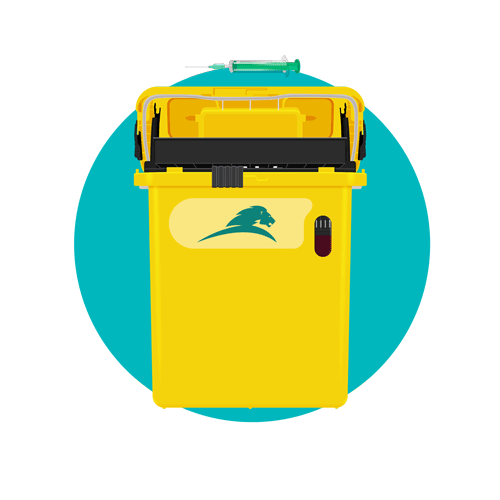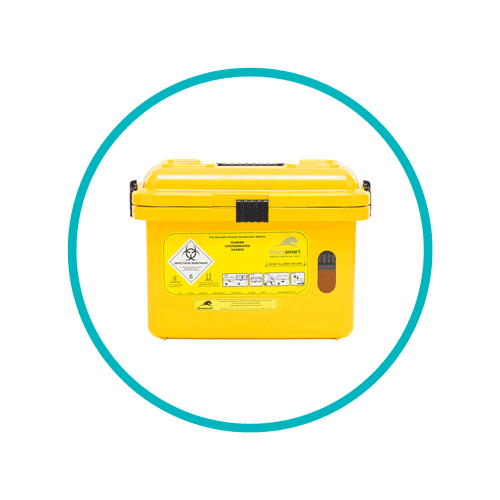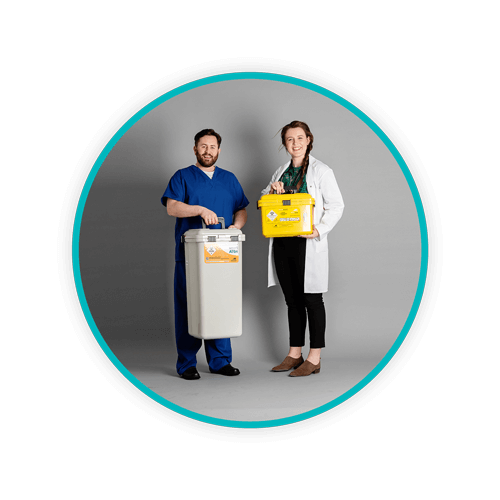Compliant Healthcare Waste Management in Leeds

Leeds, located in north central England, has enjoyed a rich history as an industrial center since the 13th century, and today is a popular urban centre averaging 800,000 inhabitants. Those inhabitants often require medical services from a number of hospitals, infirmaries, clinics, and care centres throughout the region. The NHS Trust provides a wealth of hospital and surgical services including those focused on cancer treatments, cardiovascular care, neurosurgery, and organ transplants.
Home to St. James University Hospital in Leeds Cancer Centre, the hospitals within the NHS Trust employs over 18,000 staff members, each of whom must be compliant in healthcare waste management processes.
TOPICS WE WILL COVER:
1 / Medical waste management in Leeds
3 / Compliant colour-coding guidelines
5 / Documentation essential for compliance
6 / Sharpsmart knows the regulations
Medical waste management in Leeds
As with other communities and regions throughout England, healthcare waste generators in Leeds are responsible for ensuring the proper identification of healthcare waste streams and how each is handled, treated, and disposed of in a manner that is safe not only for healthcare providers, patients, and visitors to such facilities, but also to the environment.
Links to UK governmental agency websites provides a wealth of information regarding waste processes, as well as environmental impact of such waste. Such agencies also provide guidance regarding the classification of different types of waste.
Another invaluable resource is the Department of Health publication Health Technical Memorandum 07-01: Safe Management of Healthcare Waste. The 187-page document may seem overwhelming to first-time readers but contains detailed information regarding numerous medical waste management topics, including definitions and classifications of wastes, information regarding colour-coding and storage, and requirements for labelling and preparing waste for transportation off-site.
Knowledge of waste classifications is essential. For example, an offensive waste is a non-clinical waste stream that is not infectious in nature and also does not contain any chemical or pharmaceutical substances. Clinical waste can be contaminated with chemicals or infectious agents, as well as diagnostic kits, and is to be placed in the yellow bag waste stream.
Infectious clinical waste is classified as hazardous. Anatomical waste can be hazardous or non-hazardous, depending on whether or not it is infectious or contains a chemical or toxic agent. Refer to the information in the Technical Memorandum for details.
Proper identification and classification of waste streams in any healthcare scenario is the first step toward compliant healthcare waste management and disposal processes.
About sharps disposal
Sharp instruments can pose a danger to anyone coming into contact with them. In medical scenarios, sharps can include anything that has the potential to poke, slash, or injure the skin, providing a route for infectious or bacterial contaminants. For example, needles and syringes might also be contaminated with drugs, pharmaceuticals, or toxic agents like cytotoxic and cytostatic medicines used in chemotherapy treatments.
Sharps waste is to be disposed of in a properly colour-coded and labelled leak-resistant and puncture-proof container. A valuable resource for sharps instruments used in healthcare is the Health and Safety Executive publication titled “Health and Safety (Sharp Instruments in Healthcare) Regulations 2013.”
The importance of sharps safety in Leeds hospitals and medical facilities is not to be underestimated in its potential to reduce the risk of needlestick injuries and contamination with potentially infectious diseases. These include HIV/AIDS and other bloodborne viruses – such as hepatitis B, hepatitis C – and diseases that are viral, bacterial, or fungal in nature such as diphtheria, herpes, malaria, and tuberculosis.
Specific guidelines from the Health Technical Memorandum provide all the information needed for placement, collection, and disposal of such containers.
Compliant colour-coding guidelines
For safety not only in collection within the medical care environment, but in storage and transportation off-site by waste management companies, it is vital that waste streams be appropriately contained and labelled. Such processes also encourage waste minimisation, providing cost savings for the medical facility in waste pickup, transportation, and disposal options.
It is recommended that segregation of waste streams occurs at the point of generation and that such waste goes immediately into appropriate colour-coded containers or bins. This is the first step toward compliant healthcare waste management.
Colour-coding identifies each waste stream based on its classification and suitability for certain treatment or disposal options. Compliant colour-coding in Leeds medical facilities is generally standardised by other healthcare providers throughout the region. For example:
- Cytotoxic and/or cytostatic waste is to be placed in purple-lidded containers
- Anatomical waste is disposed of in red-lidded containers
-
Pharmaceutical waste is segregated into blue-lidded containers
Some waste, such as cytotoxic or cytostatic waste, anatomical waste, and medicinal waste is destined for incineration at permitted facilities. Refer to the Health Technical Memorandum for additional details and specifications for management of other waste streams.
Maintaining compliance
Maintaining compliance requires due diligence and recognition of duty of care by every facility that produces medical waste. As such, waste audits are excellent tool in not only identifying the type of waste streams typically generated in any specific facility, but for clarity in regard to regulations and compliance. Such audits provide generators with valuable information regarding the quantity of different waste streams produced, which can be used to develop waste management procedures and policies, along with appropriate training standards for employees.
Training is essential to ensure compliance in any facility. Educating staff and ensuring that all employees understand the importance of waste stream identification and their specific handling procedures is essential for their safety and the safety of patients and visitors. Training options will vary depending on job functions and responsibilities, but should be conducted for all healthcare and auxiliary staff.
Documentation essential for compliance
Documentation is also very important for all medical care facilities in Leeds, and depends on what type of waste is produced. Movement of wastes must be documented by the medical waste generator. All hazardous wastes must be listed on a hazardous-waste consignment note. Consignment notes are not required for non-hazardous waste, although a waste transfer note is.
Sharpsmart knows the regulations
Sharpsmart is dedicated to providing products, resources, and solutions for healthcare waste management needs in Leeds and throughout the UK. We are committed to protecting the environment and reducing the volume of medical waste that ends up in landfills. Through proper handling, segregation, and disposal, we are also focused on enhancing sustainability as well as cost-effective solutions for medical providers. For more information about our Leeds operations and service options, contact us today.
